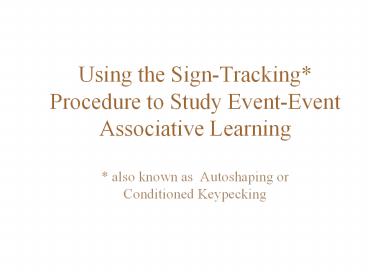Using%20the%20Sign-Tracking*%20Procedure%20to%20Study%20Event-Event%20Associative%20Learning PowerPoint PPT Presentation
Title: Using%20the%20Sign-Tracking*%20Procedure%20to%20Study%20Event-Event%20Associative%20Learning
1
Using the Sign-Tracking Procedure to Study
Event-Event Associative Learning
- also known as Autoshaping or
Conditioned Keypecking
2
Birds come into the world biologically prepared
to peck at objects in the environment. Young
birds very quickly learn to direct their pecking
more at edible items (seeds ) and less toward
non-edible items (pebbles ). What are these
young birds learning?
v
v
3
A reasonable assumption is that the birds learn
what food looks like and approach and peck those
items that have the appearance of food. Seeds
are a typical source of food for many birds.
Perhaps birds learn to associate one or more
physical characteristics of seeds (e.g., a color)
with food. They then approach and peck at small
items of that particular color. Is there
evidence that is consistent with this
assumption? Good evidence would consist of data
showing that birds approach and peck at
stimuli(signs or signals) that are associated
with food. The sign tracking procedure provides
this evidence.
4
In the natural environment the signs (signals)
associated with food are part of the food itself.
5
But in the laboratory the signs and food are
artificially separated so that responding to the
signs (signal) can be observed independent of
responding to the food.
6
The sign need not look like the real thing. It
simply needs to be within the same sensory
modality.
7
The sign is then physically separated from the
food.
8
. To a distance that allows the experimenter to
clearly distinguish between sign-directed
responding and food-directed responding.
9
OPERANT CHAMBER FOR BIRDS
KEY LIGHT
FOOD TRAY
FOOD
10
The birds are then exposed to keylight-food
pairings in a typical classical conditioning
fashion
CS key light
UCS food
11
Sign Tracking - Trial 1
12
Sign Tracking - Trial 2
13
Sign Tracking - Trial 3
14
Sign Tracking - Trial 4
15
Sign Tracking - Trial 5
16
Form of the CR in Sign Tracking
UCS Water (note the closed beak)
UCS Food (note the open beak)
From Jenkins Moore, 1973
PowerShow.com is a leading presentation sharing website. It has millions of presentations already uploaded and available with 1,000s more being uploaded by its users every day. Whatever your area of interest, here you’ll be able to find and view presentations you’ll love and possibly download. And, best of all, it is completely free and easy to use.
You might even have a presentation you’d like to share with others. If so, just upload it to PowerShow.com. We’ll convert it to an HTML5 slideshow that includes all the media types you’ve already added: audio, video, music, pictures, animations and transition effects. Then you can share it with your target audience as well as PowerShow.com’s millions of monthly visitors. And, again, it’s all free.
About the Developers
PowerShow.com is brought to you by CrystalGraphics, the award-winning developer and market-leading publisher of rich-media enhancement products for presentations. Our product offerings include millions of PowerPoint templates, diagrams, animated 3D characters and more.

